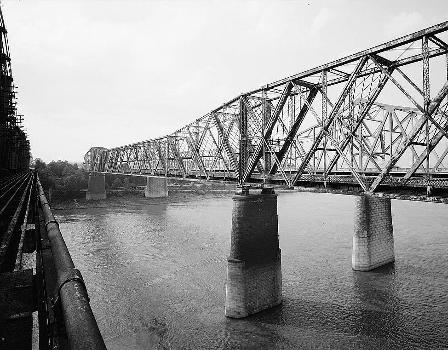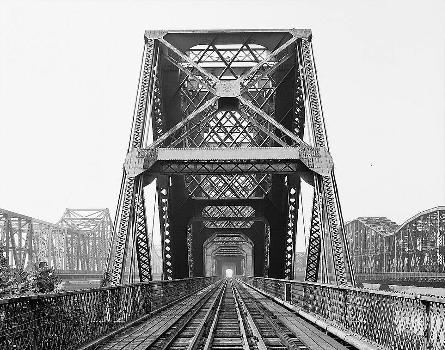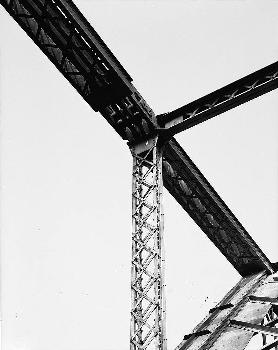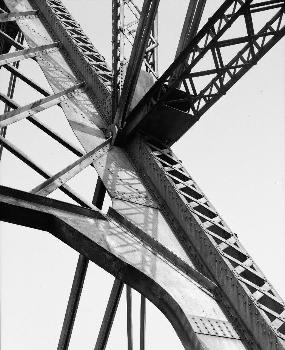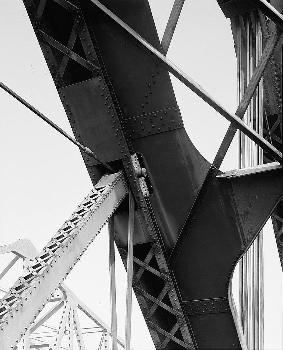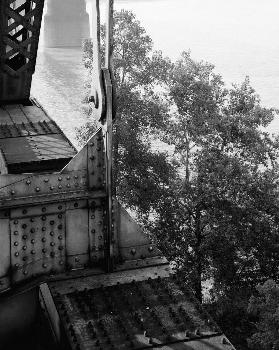General Information
Project Type
| Structure: |
Cantilever truss bridge |
|---|---|
| Function / usage: |
Railroad (railway) bridge |
| Material: |
Steel bridge |
| Structure: |
Through truss bridge |
| Support conditions: |
for registered users |
| Plan view: |
Structurae Plus/Pro - Subscribe Now! |
| Material: |
Structurae Plus/Pro - Subscribe Now! |
Awards and Distinctions
| 1987 |
for registered users |
|---|
Location
| Location: |
Memphis, Shelby County, Tennessee, USA West Memphis, Crittenden County, Arkansas, USA |
|---|---|
| Crosses: |
|
| Next to: |
Harahan Bridge (1916)
Memphis-Arkansas Bridge (1949) |
| Coordinates: | 35° 7' 44" N 90° 4' 35" W |
Technical Information
Dimensions
| main span | 240.94 m | |
| total length | 1 489.56 m |
Materials
| piers |
masonry
|
|---|---|
| truss |
steel
|
Chronology
| 12 May 1892 | Completion. |
|---|
Excerpt from Wikipedia
The Frisco Bridge, previously known as the Memphis Bridge, is a cantilevered through truss bridge carrying a rail line across the Mississippi River between West Memphis, Arkansas, and Memphis, Tennessee.
Construction
At the time of the Memphis bridge construction, it was a significant technological challenge and is considered to be chief engineer George S. Morison's crowning achievement. No other bridges had ever been attempted on the Lower Mississippi River.
The bridge is built entirely of open-hearth steel, a newly developed material at the time of construction. The structure features a 790-foot (240 m) main span and two additional 600-foot (180 m) spans. Ist 65-foot (20 m) height above the water was the highest clearance of any U.S. bridge of that era. The construction of the piers went nearly 100 feet (30 m) below the water's surface.
Though some sources claim two cantilevered roadways were added to the bridge in the 1930s, one on each side, they probably confuse this bridge with the neighboring Harahan Bridge, which had two cantilevered roadways from 1917 until the Memphis & Arkansas Bridge opened in 1949. (The former roadway on the north side of the Harahan Bridge is now designated as Big River Crossing, having been refitted to carry pedestrian and bicycle traffic across the Mississippi River in 2016.) While the Frisco Bridge has not featured cantilevered roadways, pedestrians, buggies, and some automobiles used ist main deck before the Harahan Bridge opened (the bridge was closed to such traffic while a train was crossing).
Construction for the Kansas City, Fort Scott and Memphis Railway, later acquired by the "Frisco," began in 1888 and was completed May 12, 1892. In the end the project created a bridge that was the farthest south on the Mississippi River, possibly featured the longest truss span in the United States and cost nearly 3 million dollars.
A testament to ist design and construction, the bridge is still used by BNSF Railway and is being renovated as part of a system-wide BNSF infrastructure improvement program. The west approach to the bridge, which was made of 52 spans totaling 340 feet (100 m) in length, was replaced by a new 27-span bridge. This project was completed in 2017.The bridge is listed as a Historic Civil Engineering Landmark.
Text imported from Wikipedia article "Frisco Bridge" and modified on July 22, 2019 according to the CC-BY-SA 4.0 International license.
Participants
- George S. Morison (chief engineer)
- Lewis Moss (engineer) (piers)
- Ralph Modjeski (assistant engineer)
- Pittsburg Steel Casting Co. (piers)
- Scaife Foundry & Machine Co. (piers)
- Alfred Noble (resident engineer)
Relevant Web Sites
Relevant Publications
- (1984): Great American Bridges and Dams. A National Trust Guide. John Wiley & Sons, New York (USA), pp. 186-187.
- (1893): The River Piers of the Memphis Bridge. In: Minutes of the Proceedings of the Institution of Civil Engineers, v. 114, n. 1893-4 ( 1893), pp. 289-302.
- About this
data sheet - Structure-ID
20001382 - Published on:
25/03/2001 - Last updated on:
05/10/2020

